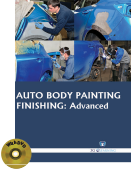Trade and Industrial Education

Auto Body Painting Finishing: Advanced comprehends various diverse practical and visual skills with knowledge of specialized materials and techniques. Automotive paint technicians, or automotive painters, are classed as transportation equipment painters, which is one kind of painting and coating worker. There are typically three specialties within vehicle painting: the refinishing of older or damaged vehicles, the painting and clear-coating of new cars, and related paint work, such as the painting of large equipment or ships. Auto body paint technicians perform intricate, detailed work that requires matching new paint to old colors and applying it with a spray gun. Other tasks may include hand painting areas or operating dip-painting equipment. This book will introduce the knowledge and skills for those studying and/or working in automotive industry to interpret and convey information in response to workplace requirements.
About this Book
The information in this book consists of competencies that a person must achieve to repair pearl/mica metallic body panels specifically applying the skill in pearl/mica, metallic color matching. It also covers the competency in painting pearl or mica colors.
About the Auto Body Painting Industry
Automotive painters make cosmetic repairs to vehicles and repaint them, often after collisions. Most auto body painter positions don’t require a specific level of education beyond high school; however, formal training in the field is available and is becoming more commonly required. Auto body painters must know how to maintain and operate the equipment used and may need some skill in body repair. In some facilities, they will need to learn the skills to create specialized paint finishes. Auto body painters communicate with clients, employers and other employees to plan and execute repair and painting jobs on a variety of vehicles, including cars, trucks and buses. Depending on their employers, auto body painters may be required to have knowledge of specialty painting techniques. Some auto body painters may need collision repair capabilities as well. In preparation for a painting project, auto body painters remove rust and other debris from surfaces to be painted, fill cavities and dents in vehicles to create an even surface, mask or tape off details and components to avoid contamination and select the proper colors and substances for the project. The painting process itself involves using paint sprayers and brushes to apply paint to a vehicle, determining the necessary application of paint for a thorough coat and checking for runs or sags in the paint to ensure a quality product. Auto body painters are expected to see a growth of 10% from 2012-2022, according to the U.S. Bureau of Labor Statistics, which is about average for all professions. The BLS said most new positions will be in auto body repair facilities. The same agency reported that these painters earned a mean wage of $43,930 in May 2013. Painters in automobile repair and maintenance facilities had a mean wage of $44,070 at that time, while those employed by automobile dealerships earned $47,330.